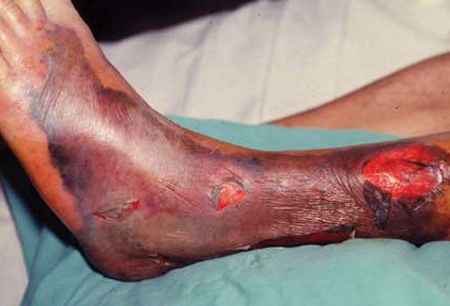Etiology
Vibrio species are natural inhabitants of ocean and brackish waters.[10] In the US, they are most commonly isolated from southeastern Atlantic, Gulf, and Pacific waters. They are present in the tissue of shellfish, including oysters, mussels, clams, shrimp, and crabs. Ten Vibrio species, of >140 identified, have been associated with disease in humans. Of those, Vibrio vulnificus, Vibrio parahaemolyticus, and Vibrio alginolyticus contribute to most human infections. V vulnificus is the most virulent member of the group.[11][12]
Infection from marine/estuarial non-cholera vibrios results from exposure to brackish or sea water with an existent open skin lesion or a penetrating wound, or through ingestion of uncooked or partially cooked shellfish. Infection risk and mortality are highest in patients with underlying hepatic cirrhosis from alcohol, chronic hepatitis B or C infection, hemochromatosis, diabetes, or malignancy, those being treated with corticosteroids, or those who are immunocompromised. In patients with hepatic disorder or iron storage disorders (e.g., cirrhosis, hemochromatosis) or in those who are immunocompromised, V vulnificus, either through ingestion or wound inoculation, can produce rapidly fatal septic shock with or without associated necrotizing soft-tissue infection.[10][13][14][15][16][Figure caption and citation for the preceding image starts]: Gangrenous change with hemorrhagic bullae in a patient with cirrhosis who developed septic shock and Vibrio vulnificus bacteremiaFrom the image collection of the Centers for Disease Control and Prevention [Citation ends].
V parahaemolyticus is most commonly associated with a self-limiting, seafood-associated gastroenteritis in an otherwise normal host.[10] It has been associated with rare cases of septicemia and death.
V alginolyticus less commonly produces gastroenteric disease and is most often associated with superficial ear or eye diseases in otherwise healthy young people with swimming or surfing marine water exposure.[4][12] It has also caused soft-tissue infections in traumatic wounds contaminated with seawater.[17][18][19][20]
Pathophysiology
Virulence of Vibrio vulnificus has been associated with multiple factors. The organism can produce siderophores enabling it to scavenge iron from host transferrin and hemoglobin. It produces hemolysins that lyse mammalian erythrocytes and are cytotoxic for tissue, a metalloprotease that has both elastolytic and collagenolytic activity, and a capsular polysaccharide that can activate the host cytokine system.[21][22] In vitro studies in mice suggest that a V vulnificus metabolic product, cyclo(L-phenylalanyl-Lproline) or cFP, may act as a virulence factor by inhibiting macrophage Toll receptor downstream signaling of nuclear factor kappa B. This would dampen the production of inflammatory cytokines as part of the innate immune response to infection.[23]V vulnificus also produces a potent cytotoxin, repeats-in-toxin A1 or RtxA1, felt to be a significant virulence factor.[24]
Virulence factors of V parahaemolyticus include a thermostable direct hemolysin (TDH) and two type 3 secretion system (T3SS) injectosome apparatuses. The TDH may function as a porin in the enterocyte plasma membrane, allowing ion flux and cell death. The T3SS allows injection of bacterial proteins directly into host cells.[14] The organism possesses host cell membrane-binding adhesion molecules facilitating the contact necessary for T3SS function and cell penetration. It also possesses a siderophore system for capturing and delivering iron.[25][26] In vitro studies in tissue culture cells have demonstrated that intracellular endosomally-located bacteria are able to escape prior to endolysosome formation and successfully replicate in the cell cytosol.[27]
Classification
Taxonomy and description for vibrios[1]
The genus Vibrio belongs to the family Vibrionaceae and is characterized by motile, gram-negative, curved- to comma-shaped bacteria:
Phenotypically, they are oxidase-positive, glucose-fermenting organisms, whose growth is either stimulated by or dependent on the presence of Na+ ions.
The non-cholera vibrios are distinguished from Vibrio cholerae by the latter's ability to grow without Na+, and on further biochemical and serologic testing including agglutination in O1 or O139 antisera.
The non-cholera vibrios (halophilic vibrios) are further distinguished by their Na+ requirement for growth and biochemical characteristics, including fermentation of sucrose and lactose and utilization of lysine or ornithine as metabolic substrates.
Integrated Taxonomic Information System - Vibrio Taxonomy[2]
Family: Vibrionaceae
Genus: Vibrio
Species: >85 non-cholera Vibrio species
Use of this content is subject to our disclaimer